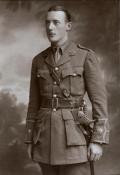
War Memorial
| Captain Roger Searle WHITMORE MC | |
|
D Company, 1st Battalion King’s Shropshire Light Infantry Date of birth: 25th May 1894 Date of death: 20th November 1917 Died of wounds aged 23 Buried at Ribecourt British Cemetery Row B Grave12 |

|
| Roger Searle Whitmore was born at "Sunnyside", Withyham in East Sussex on the 25th of May 1894 the second son of Herbert Searle Whitmore, director of a tannery, and Annette (nee Watkins) Whitmore of The Red House, Tenchley's Park, in Limpsfield. He was educated at Hazelwood School until April 1908 where he was a member of the Football XI in 1905, 1906 and 1907, when he was Captain. He was a member of the Cricket XI in 1906 and 1907. The school magazine wrote the following on his 1905 football season: - "(Right half) - kicks splendidly, but is a weak tackler; with improvement in this latter respect likely to prove a very serviceable back." Of his 1906 football season they wrote: - "(Back) - Always a tower of strength in defence; kicks finely and can turn a "corner" to advantage, but is slow and reluctant to utilise his weight. An injury to his ankle proved a heavy handicap." Of his 1907 football season they wrote: - "Capt. (Inside right) - Cannot be said to have realised expectations, but as he appeared in no less than three different positions, it may fairly be said that he sacrificed personal success in the interests of the side as a whole; has brought to a very high pitch the art of corner kicking." They wrote the following on his 1906 cricket season: - "A good forward player to straight bowling, but utterly useless to crooked stuff; a fair field on the ground." Of his 1907 cricket season they wrote: - "Probably the best bat in team with a very fine shot past extra cover, but owing to nervousness seldom able to do himself justice; a very fair field, an on his day a dangerous bowler." On leaving the school the magazine wrote of him: - "...joins his brother at Marlborough. He was in both the Cricket and Football XI, and is a promising golfer. Also a useful member of the choir. We shall miss him and wish him all luck." He went on to Marlborough College where he was in C3 House from May 1908 to December 1911. He was a member of the Officer Training Corps from 1909 to 1911 where he rose to the rank of Lance Corporal. He was a member of Limpsfield Chart Golf Club. He applied for a commission in the Special Reserve of Officers on the 20th of September 1913 and underwent a medical examination at Woolwich on the 30th of September where is was recorded that he was 5 feet 10 inches tall and that he weighed 160 lbs. He was commissioned as a 2nd Lieutenant on probation in the King's Shropshire Light Infantry on the 1st of October 1913 and from the 1st of November 1913 he served with the 3rd (Reserve) Battalion of his regiment at Tipperary. He left Ireland on the 30th of April 1914 and was confirmed in his rank in June 1914. He was promoted to Lieutenant on the 26th of September 1914. On the outbreak of war he was with the 3rd (Reserve) Battalion at Shrewsbury and left for France from Pembroke Dock Chatham on the 27th of November 1914 joining the 1st Battalion in the field on the 3rd of December when they were at Flamingerie Farm near Armentieres.He was admitted to the 18th Field Ambulance on the 31st of January 1915. On the 8th of August 1915 he was given temporary command of A Company and was wounded with them in an attack on Hooge Crater the following day. He was invalided home and underwent two operations. On the 27th of August 1915 a Medical Board sat in London to consider his case:- "At Hooge on the 10th of August 1915 he was wounded by a fragment of shrapnel which struck him at the external angle of the right supre orbital ridge. Whence the piece of shrapnel was removed on the 26th of August the wound was slight and has quite healed--no bone, vessel of nerve injury. But he is neurasthenic after the strain of 10 months trench and other fighting. His symptoms, nervousness, tremulousness of the hand and muscles of the neck and head. Marked hesitancy in speaking--loss of self confidence. In childhood he was somewhat astigmatic and wore glasses which he discarded when he was fifteen years old, but during the last few months the condition has reappeared. He is somewhat better but requires rest and quiet for two months." On the 26th of October 1915 a Medical Board was convened at Guildford which reported the following: "He is still sleepless, has a slight hesitation in his speech and is no doubt suffering from neurasthenia in a mild form. Physically he feels quite well. He would probably recover more quickly if he were occupied!" On the 22nd of November he was posted to the 3rd (Reserve) Battalion of his regiment at Bush Camp, Pembroke Dock for light duties. A Medical Board which sat at the Military Hospital Pembroke on the 13th of December 1915 recorded that his wound was healed and that the gastric enteritis, from which he had been suffering since the 27th of October, had recovered. They noted, however, that he was still suffering from nervous attacks and he was passed fit for light duty. A Medical Board which sat at the Military Hospital Pembroke on the 16th of January 1916 concluded that he was fit for general service. He re-joined the Battalion on the 16th of May 1916 when the battalion was in trenches on the Ypres to Pilkem Road. He was posted as second in command of D Company. He was given temporary command of D Company on the 13th of July 1916. From the 19th to the 24th of July 1916 he reported sick at the Field Ambulance. He was promoted to Captain in the field and put in command of D Company on the 28th of October 1916. He went home on leave for the period 14th of November to the 25th of November 1916. On the 15th of February 1917 around fifty German troops of the 165th Infantry Regiment raided D Company's positions in the Hohenzollern sector of the Loos front. In the event, the attack was broken up by artillery and Lewis gun fire while the enemy were assembling in no man's land and their attack did not make the British lines. A patrol was sent out later which recovered one of the German dead. From the 22nd of February to the 4th of March 1917 he was back at the Field Hospital, returning there again four days later. He rejoined from the base on the 4th of May and resumed command of D Company. From the 22nd of June to the 29th 1917 he was sent on a Lewis Gun course at Le Touquet. At 2.55am on the 7th of July 1917 the Germans launched another major raid against D Company's positions at Mazingarbe which was preceded by an intense bombardment of their positions lasting some fifteen minutes. The company held their position with six of them being awarded medals for gallantry, among them, was Roger Whitmore who was awarded the Military Cross. D Company had suffered casualties of nineteen other ranks killed and a further fourteen wounded during the attack. The citation for his award appeared in the London Gazette of the 17th of September 1917 and read as follows:- "For conspicuous gallantry and devotion to duty during a hostile raid on our trenches. Throughout an intense bombardment by every description of projectile. He kept his line manned and successfully repulsed the enemy. He showed admirable skill and energy in organising the defence, and later in re-establishing the line when it had been practically flattened by the violence of the barrage." At 8pm on the evening of the 19th of November 1917 the 1st Battalion King's Shropshire Light Infantry arrived at a sunken road between Villers-Plouich and Beaucamps in preparation for an attack the following day. At 9pm they moved to their first assembly positions and were in place at 10.30pm. At 1.30am A Company and the Battalion Headquarters moved up to Plough Trench, which was to be the support line during the attack. By 4.30am B Battalion of the Tank Corps was in position with B Company and Roger Whitmore's D Company formed up behind them. C Company, who were to attack in support of the 8th Battalion Bedfordshire Regiment, took over the front line from the 5th Battalion York and Lancaster Regiment. The men were all in place by 5.30am with zero hour set for 6.20am. At 6.40am C Company went into the attack, quickly passing through the Bedfordshire men, who had successfully taken the enemy outpost to their front as well as the first line trench of the Hindenburg Line. At 7.10am B and D Companies left their assembly trenches to attack and capture the final objective, the Hindenburg Line support line known as Kaiser Trench. They encountered little opposition until the final stages of their advance when they came under heavy machine gun fire. This fire caused wounded two officers and killed or wounded twenty other ranks from the two companies but, in spite of this obstacle the enemy line was taken and consolidated. Roger Whitmore was one of the wounded officers and he died later the same day. His parents received the following telegram dated the 27th of November 1917:- "Regret to inform you Capt R.S. Whitmore MC King's Shropshire Light Infantry was wounded November twentieth. Details passed when received." The next day another telegram was sent dated the 28th of November 1917:- "Deeply regret to inform you Capt R.S. Whitmore MC King's Shropshire light Infantry died of wounds November twentieth. The Army Council express their sympathy." He is commemorated on the war memorial at Limpsfield, on the memorial at Marlborough College and on the memorial at the site of the Whitmore Tannery at Edenbridge. He is also commemorated on the memorial at Limpsfield Chart Golf Club. |
|
| Went on to Marlborough College |
Back